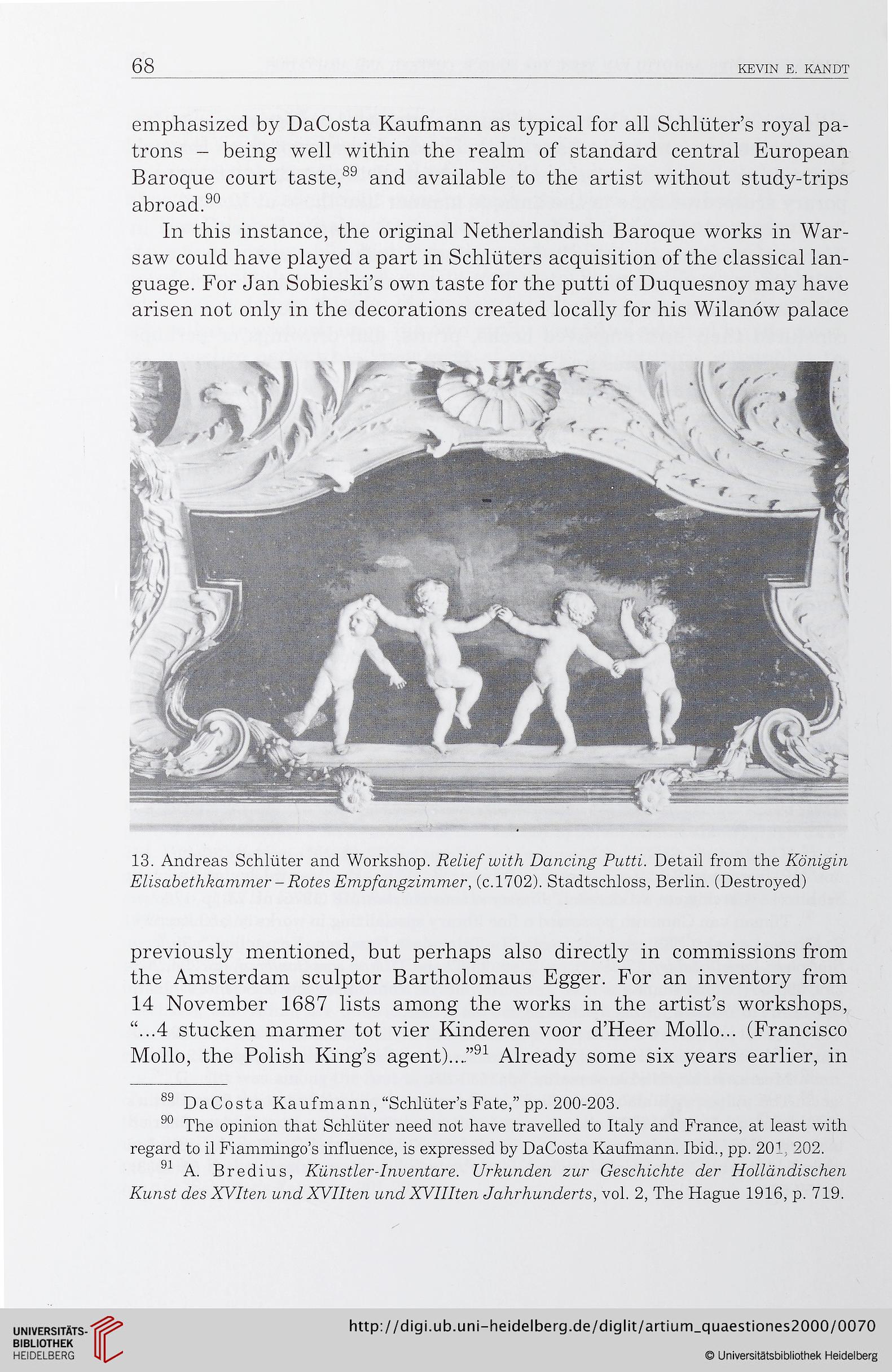68
KEVIN E. KANDT
emphasized by DaCosta Kaufmann as typical for ail Schlüter’s royal pa-
trons - being well within the realm of standard central European
Baroque court taste,89 and available to the artist without study-trips
abroad.90
In this instance, the original Netherlandish Baroque works in War-
saw could hâve played a part in Schlüters acquisition of the classical lan-
guage. For Jan Sobieski’s own taste for the putti of Duquesnoy may hâve
arisen not only in the décorations created locally for his Wilanôw palace
13. Andréas Schlüter and Workshop. Relief with Dancing Putti. Detail from the Konigin
Elisabethkammer - Rotes Empfangzimmer, (c. 1702). Stadtschloss, Berlin. (Destroyed)
previously mentioned, but perhaps also directly in commissions from
the Amsterdam sculptor Bartholomaus Egger. For an inventory from
14 November 1687 lists among the works in the artist’s workshops,
“...4 stucken marmer tôt vier Kinderen voor d’Heer Mollo... (Francisco
Mollo, the Polish King’s agent)....”91 Already some six years earlier, in
89 DaCosta Kaufmann, “Schlüter’s Fate,” pp. 200-203.
90 The opinion that Schlüter need not hâve travelled to Italy and France, at least with
regard to il Fiammingo’s influence, is expressed by DaCosta Kaufmann. Ibid., pp. 201, 202.
91 A. Bredius, Künstler-Inventare. Urkunden zur Geschichte der Hollandischen
Kunst des XVIten und XVIlten undXVIIIten Jahrhunderts, vol. 2, The Hague 1916, p. 719.
KEVIN E. KANDT
emphasized by DaCosta Kaufmann as typical for ail Schlüter’s royal pa-
trons - being well within the realm of standard central European
Baroque court taste,89 and available to the artist without study-trips
abroad.90
In this instance, the original Netherlandish Baroque works in War-
saw could hâve played a part in Schlüters acquisition of the classical lan-
guage. For Jan Sobieski’s own taste for the putti of Duquesnoy may hâve
arisen not only in the décorations created locally for his Wilanôw palace
13. Andréas Schlüter and Workshop. Relief with Dancing Putti. Detail from the Konigin
Elisabethkammer - Rotes Empfangzimmer, (c. 1702). Stadtschloss, Berlin. (Destroyed)
previously mentioned, but perhaps also directly in commissions from
the Amsterdam sculptor Bartholomaus Egger. For an inventory from
14 November 1687 lists among the works in the artist’s workshops,
“...4 stucken marmer tôt vier Kinderen voor d’Heer Mollo... (Francisco
Mollo, the Polish King’s agent)....”91 Already some six years earlier, in
89 DaCosta Kaufmann, “Schlüter’s Fate,” pp. 200-203.
90 The opinion that Schlüter need not hâve travelled to Italy and France, at least with
regard to il Fiammingo’s influence, is expressed by DaCosta Kaufmann. Ibid., pp. 201, 202.
91 A. Bredius, Künstler-Inventare. Urkunden zur Geschichte der Hollandischen
Kunst des XVIten und XVIlten undXVIIIten Jahrhunderts, vol. 2, The Hague 1916, p. 719.





